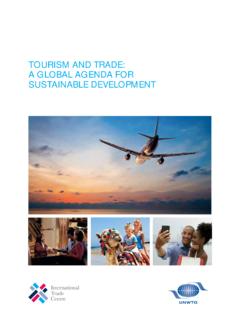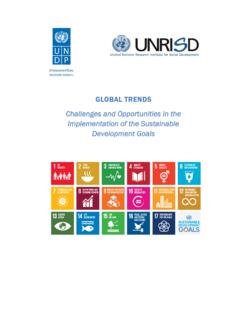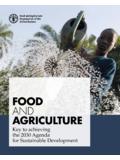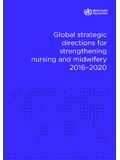Transcription of Regional and Global Costs of Attaining the Water …
1 Regional and Global Costs of Attaining the Water Supply and Sanitation Target (Target 10) of the millennium development goals Guy Hutton Jamie Bartram Public Health and the EnvironmentAssessing & Managing Environmental Risks to Health WHO/HSE/AMR/08/01 Regional and Global Costs of Attaining the Water Supply and Sanitation Target (Target 10) of the millennium development goals Prepared by: Guy Hutton, Water and Sanitation Program East Asia & Pacific Region, World Bank (work conducted while at DSI development Solutions International, Basel, Switzerland) Jamie Bartram, World Health Organization, Geneva, Switzerland Public Health and the Environment World Health Organization Geneva 2008 Regional and Global Costs of Attaining the Water Supply and Sanitation Target (Target 10) of the millennium development goals World Health Organization 2008 The illustration on the cover page is extracted from Rescue Mission: Planet Earth, Peace Child International 1994; used by permission.
2 All rights reserved. Publications of the World Health Organization can be obtained from WHO Press, World Health Organization, 20 Avenue Appia, 1211 Geneva 27, Switzerland (tel.: +41 22791 3264; fax: +41 22 791 4857; e-mail: Requests for permission to reproduce or translate WHO publications whether for sale or for noncommercial distribution should be addressed to WHO Press, at the above address (fax: +41 22 791 4806; e-mail: The designations employed and the presentation of the material in this publication do not imply the expression of any opinion whatsoever on the part of the World Health Organization concerning the legal status of any country, territory, city or area or of its authorities, or concerning the delimitation of its frontiers or boundaries. Dotted lines on maps represent approximate border lines for which there may not yet be full agreement. The mention of specific companies or of certain manufacturers products does not imply that they are endorsed or recommended by the World Health Organization in preference to others of a similar nature that are not mentioned.))
3 Errors and omissions excepted, the names of proprietary products are distinguished by initial capital letters. All reasonable precautions have been taken by the World Health Organization to verify the information contained in this publication. However, the published material is being distributed without warranty of any kind, either expressed or implied. The responsibility for the interpretation and use of the material lies with the reader. In no event shall the World Health Organization be liable for damages arising from its use. Sub-regions (or Regional subdivision or reference to sub-regions) contained in this document are solely for the purposes to facilitate the presentation of data and do not have organizational status otherwise. The named authors alone are responsible for the views expressed in this publication. Printed by the WHO Document Production Services, Geneva, Switzerland iii CONTENTS SUMMARY .. iv ACKNOWLEDGEMENTS.
4 V ACRONYMS AND ABBREVIATIONS ..v INTRODUCTION ..1 METHODS ..2 Water and sanitation coverage ..2 Interventions ..5 Alternative RESULTS ..8 DISCUSSION ..16 REFERENCES ..19 ANNEX A: WHO epidemiological subregions ..21 ivSummary Target 10 of the millennium development goals (MDGs) is to halve, by 2015, the proportion of people without sustainable access to safe drinking Water and basic sanitation . This study presents Regional and Global estimates of the cost of Attaining the Water and sanitation MDG target. Improved Water and sanitation coverage data for 1990 and 2004 are used to estimate the population to be covered to attain the MDG target, taking into account population growth until 2015. The targeted population is assumed to receive improved Water and sanitation in equal annual increments from the beginning of 2005 (the base year) until the end of 2014. Investment and recurrent Costs per capita are applied to the target population.
5 Country data are aggregated to 11 World Health Organization (WHO) developing country subregions and globally. Estimated spending required in developing countries to provide new coverage to meet the MDG target is 42 billion United States dollars (US$) for Water and US$ 142 billion for sanitation, or a combined annual equivalent of US$ 18 billion. The cost of maintaining existing services totals an additional US$ 322 billion for Water supply and US$216 for sanitation, or a combined annual equivalent of US$ 54 billion. Spending for new coverage is focused mainly on rural areas (64%), whereas spending for maintaining existing coverage is focused mainly on urban areas (73%). Additional programme Costs incurred administratively outside the point of delivery of interventions of between 10% and 30% are required for effective implementation. In assessing financing requirements, estimates of cost should include the operation, maintenance and replacement of existing coverage as well as Costs of new services and programme Costs .
6 Country-level costing studies are needed to guide financing. This report is an expanded version of the paper Global Costs of Attaining the Water and Sanitation MDG Target , incorporating additional data and presentational detail, and is published in response to requests for this additional information. vAcknowledgements WHO wishes to express its appreciation to all those whose efforts made this study possible, in particular Guy Hutton, DSI development Solutions International, Basel, Switzerland, Jamie Bartram, World Health Organization, Geneva, Switzerland, and Tessa Tan-Torres, World Health Organization, Geneva, Switzerland. WHO also thanks the anonymous peer reviewers for their comments on the shorter form of this paper published in the Bulletin of the World Health Organization 2008;86:13 19. Acronyms and abbreviations AFR WHO African Region (see Annex A) AMR WHO Region of the Americas (see Annex A) EMR WHO Eastern Mediterranean Region (see Annex A) EUR WHO European Region (see Annex A) GDP gross domestic product HC household connection JMP Joint Monitoring Programme for Water Supply and Sanitation (run by WHO and UNICEF) LAC Latin America and the Caribbean MDG millennium development Goal OECD Organisation for Economic Co-operation and development SEAR WHO South-East Asia Region (see Annex A) UNICEF United Nations Children s Fund US$ United States dollars VIP ventilated improved pit-latrine WHO World Health Organization WPR WHO Western Pacific Region (see Annex A) 1 Introduction Goal 7 of the millennium development goals (MDGs) addresses environmental sustainability, with a target (target 10)
7 To halve, by 2015, the proportion of people without sustainable access to safe drinking Water and basic sanitation (1). The attainment of target 10 also contributes to the reduction of child mortality (target 5), a decrease in the incidence of major infectious diseases (target 8), improvement of maternal health (target 6) and improvement of the quality of life of slum populations (target 11). Improved Water and sanitation also contribute to gender equality and empower women (goal 3), being linked to school enrolment and attendance, especially of girls. Meeting the target would deliver further development benefits and contribute to poverty reduction (target 1) and hunger reduction (target 2) through use of Water supply for industry and agriculture, saving productive time in accessing closer Water sources and sanitation facilities, and contributing to workforce health. Importantly, improved Water supply and sanitation promote economic equity, since the unserved tend to be the poorer, more vulnerable members of society.
8 In working towards the MDG target for Water and sanitation, it is critical to understand what resources are required, where they need to be deployed and whether there are financing gaps. Corresponding assessments need to be based on reasonable estimates at Global , Regional and country levels (2). Furthermore, comparing estimated Costs required with existing funding levels helps to mobilize resources and to direct efforts to specific contexts ( rural or urban) and to countries that are off-track (3). Since 2000, several studies have estimated the cost of Attaining one or both of the components of the target for Water and sanitation at the Global (4 8) and Regional (2, 9, 10) levels. Reviews have compared these Costs , which are in the range of 9 billion to 30 billion United States dollars (US$) per year at the Global level (11, 12). This wide range is largely explained by the different methodologies and unit cost assumptions.
9 Different approaches to incremental improvement and definitions of adequate service levels also contribute to the differences. Most studies have ignored the Costs of maintaining existing coverage levels (the Costs of operating, maintaining, monitoring and replacing existing infrastructure and facilities) especially important as the Global stock of assets increases and in light of reports indicating wide variability in effective working life . Toubkiss (12) concludes, based on Global cost studies, that approximately US$ 10 billion per year would be required to supply low cost Water and sanitation services to people who are not currently supplied, and a further US$ 15 to 20 billion a year to provide them with a higher level of service and to maintain current levels of service to people who are already supplied (our emphasis). Future financing studies should consider Costs of operation, maintenance and replacement of existing as well as new Water and sanitation infrastructure and facilities (12).
10 A major component of variability for sanitation is technology choice: a low-cost household improved latrine can provide both safety and privacy, yet the cost of waterborne sewerage systems must also include the cost of treatment to reduce health and environmental risks from the discharged wastewater. Thus, Toubkiss (12) concludes that in addition to the above Costs , up to US$ 80 billion is projected solely for collecting and treating household (page 7). 2 The divergence of previous Global cost studies of Water and sanitation is partially explained by differences in methodology, leading to some convergence in estimates when these are taken into account (11, 12). Nevertheless, previous studies suffer methodological weaknesses or simplifying assumptions that make the cost estimates difficult to interpret; hence, the crude figures presented above are still incomplete.

















